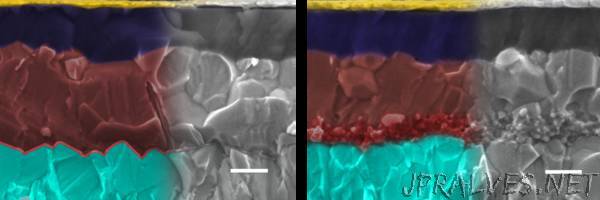
“The nominal cell operating life of perovskite solar cells is strongly influenced by their inner architecture.This was shown by two scientists at the Helmholtz-Zentrum Berlin and the Technical University of Munich. They combined experiments with numerical simulations in order to explain this observation.
In only a few years, efficiencies of perovskite solar cells have been raised from 3 per cent to more than 20 per cent. What is more, the material is inexpensive and easy to process, promising a great future for photovoltaics. Unfortunately, there are still some issues, for instance with their nominal operating life: Conversion efficiencies decrease sharply when the material is exposed to UV radiation and electric field, as is the case in real operating conditions. Now, Dr. Antonio Abate, head of a Helmholtz Young Investigators Group at HZB and Prof. Allessio Gagliardi, TU Munich, have published new results on the influence of the architecture of perovskite cells on their nominal operating life in the Journal ACS Energy Letters.
The scientists explored different architectures of perovskite cells, preparing them under identical conditions using metal-oxide electron transport layers (ETL) such as TiO2 and SnO2. One group of cells had a planar interface between perovskite and ETL, whereas in the other one a mesoporous interface was built up, intermingling perovskite and metal oxide to form a sponge like structure that contains a huge number of extremely tiny pores. Surprisingly, the perovskite cell with the mesoporous interface exhibits better output stability over time than the planar ETL-perovskite interface.
After careful experimental observations and numerical simulations, the scientists are now able to provide an explanation: “The benefit induced by the mesoporous interface is fundamentally due to its large surface area”, Abate explains. Defects that compromise the power output and operating life and which accumulate during operation at the ETL tend to get diluted in this large surface.
The scientists could even obtain a threshold density for those defects: Above a certain threshold, the output power of the solar cell decreases rapidly. But below this threshold the maximum power output remains stable. “We demonstrated that devices in a mesoporous configuration are more resilient to defect accumulation than in a planar configuration”, Abate concludes.
The results are published in ACS Energy Lett., (2018): Mesoporous Electron-Selective Contacts Enhance the Tolerance to Interfacial Ion Accumulation in Perovskite Solar Cells, A. Abate & A. Gagliardi”
